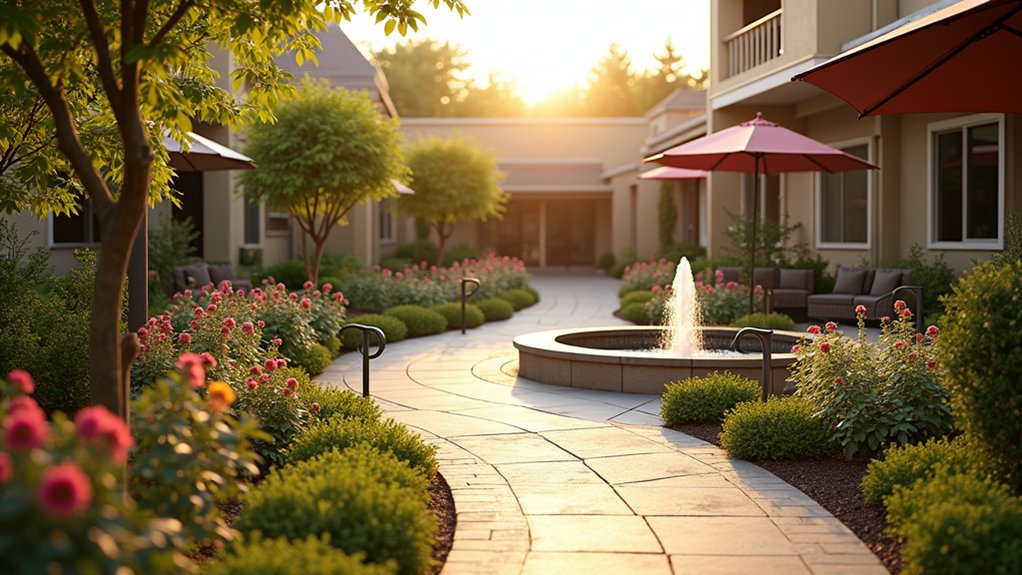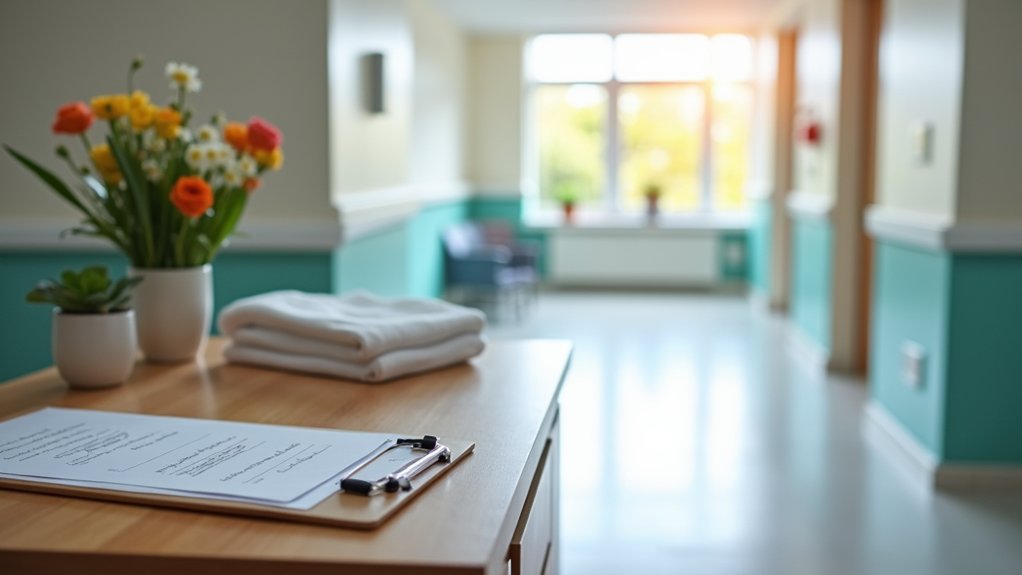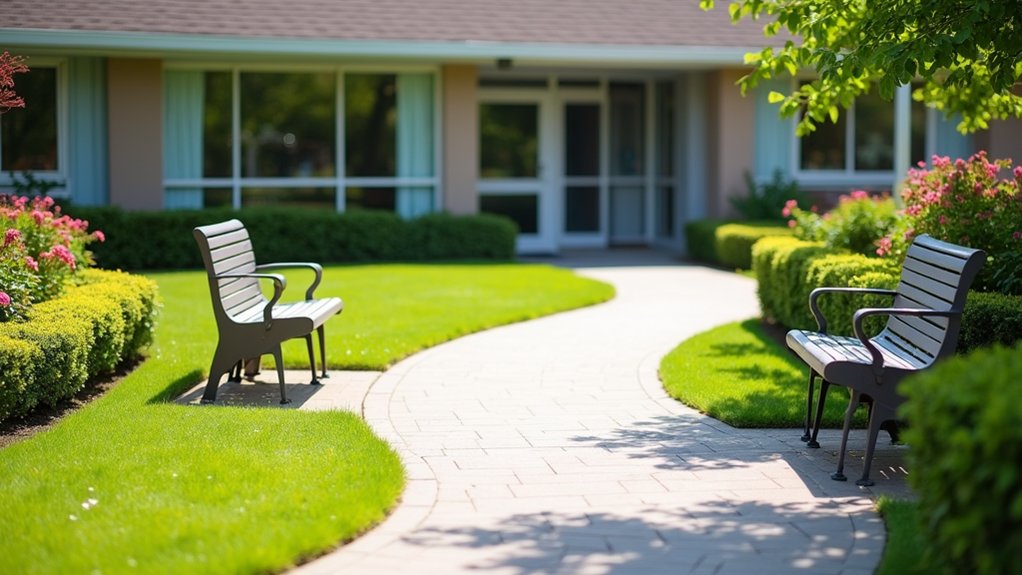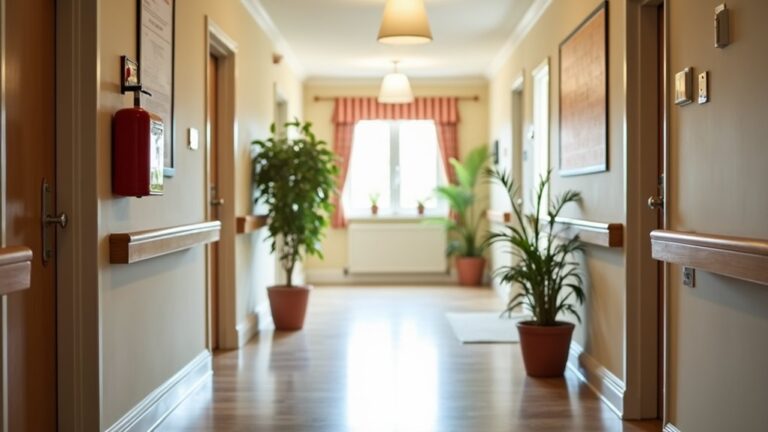Standards for Elderly Care Facilities Explained

When exploring standards for elderly care facilities, you’ll find they cover key areas to guarantee safety and quality. You’re expected to see strict regulatory guidelines on staffing and record-keeping, essential safety measures like grab bars and smoke detectors, personalized care plans for residents, proper caregiver training, and accessible, well-maintained spaces. These standards protect your loved ones’ well-being. Stick around to uncover deeper insights into how these rules shape exceptional care environments.
Key Takeaways
- Elderly care facilities must adhere to local and national staffing standards for adequate trained personnel.
- Safety measures include grab bars, smoke detectors, and accessible emergency exits to prevent accidents.
- Personalized care plans address residents’ unique physical, emotional, and social needs for quality care.
- Regular staff training on dementia care and emergency response ensures updated best practices.
- Facilities must maintain accessibility with ramps, wide doorways, and clear signage for mobility support.
Key Regulatory Guidelines for Care Homes

While ensuring the well-being of elderly residents is paramount, care homes must adhere to strict regulatory guidelines to maintain safety and quality. You’ve chosen a noble path in serving others, and understanding these rules helps you provide the best care.
Start by familiarizing yourself with local and national standards that govern staffing ratios, ensuring you’ve got enough trained hands to meet residents’ needs.
Begin by mastering local and national staffing standards to guarantee you have sufficient trained staff to support residents’ needs effectively.
Next, prioritize documentation. You’ll need to keep detailed records of each resident’s care plan, medical history, and daily activities to comply with oversight requirements.
Regular staff training is also key—make sure you’re updating your skills and knowledge to meet evolving standards.
Finally, engage with regulatory bodies for inspections and feedback. You’re not just following rules; you’re building trust with families and residents. Additionally, understanding the cost of assisted living can support financial planning and resource allocation in your facility.
Essential Safety Measures in Residential Facilities
As you focus on creating a secure environment for elderly residents, implementing essential safety measures in residential facilities becomes a top priority. You’ve got to guarantee that every space is equipped with grab bars in bathrooms and hallways to prevent falls.
Install smoke detectors and fire extinguishers on every floor, and don’t skip regular maintenance checks to keep them functional. Make certain emergency exits are clearly marked and accessible, so you’re prepared for any crisis.
You should also prioritize non-slip flooring to reduce hazards and keep walkways free of clutter. Train your staff in emergency procedures, so they’re ready to act swiftly if needed.
Regularly inspect electrical systems to avoid potential risks, and secure heavy furniture to walls for added stability. By staying vigilant and proactive, you’re not just meeting standards—you’re safeguarding the well-being of those who depend on your care and dedication every day. Additionally, consider implementing personalized care plans to address the unique needs of each resident, ensuring their safety and comfort in the facility.
Quality of Care Benchmarks for Elderly Residents

Let’s shift focus to the benchmarks that define quality of care for elderly residents in your facility. You’ve got a crucial role in guaranteeing their well-being, and it starts with meeting key standards.
Prioritize personalized care plans that address each resident’s unique physical, emotional, and social needs. Make certain you’re regularly evaluating their health to catch any issues early and adjust support as needed.
Focus on crafting personalized care plans that meet each resident’s distinct physical, emotional, and social needs with regular health evaluations.
Beyond health, foster a nurturing environment. Encourage meaningful activities that boost mental engagement and build community among residents. Confirm you’re providing nutritious meals tailored to dietary needs, promoting both health and enjoyment.
Listening to residents and their families is essential, as it helps create a supportive environment that enhances their sense of community and belonging. Maintain clean, comfortable living spaces that feel like home.
Staffing Requirements and Training Standards
Since quality care hinges on a skilled team, guarantee your facility meets strict staffing requirements and training standards. You’ve got to make certain there’s enough staff to provide personalized attention to every elderly resident.
Maintain proper ratios of caregivers to residents, so no one feels neglected. Hire compassionate individuals who are enthusiastic to serve, and verify they’ve the necessary qualifications, like certifications in geriatric care.
Beyond numbers, focus on training to elevate their skills. Implement regular programs covering essential topics like dementia care, emergency response, and emotional support. Assisted living facilities should also continuously evaluate their training programs to ensure staff are equipped with the latest best practices.
Encourage ongoing education to keep your team updated on best practices. Foster a culture of empathy, making sure your staff understands the unique needs of the elderly.
When you prioritize robust staffing and thorough training, you’re not just meeting standards—you’re creating a nurturing environment where residents thrive, and your dedication to serving others shines through every day.
Facility Maintenance and Accessibility Norms

While guaranteeing quality care starts with staffing, don’t overlook the importance of maintaining your facility and meeting accessibility norms. As someone dedicated to serving the elderly, you’ve got to keep the environment safe and welcoming.
Regularly inspect and repair flooring, lighting, and plumbing to prevent accidents. Make sure hallways are clear and equipment is in working order, so residents feel secure moving around.
Beyond maintenance, prioritize accessibility to honor every individual’s dignity. Install ramps and grab bars to support those with mobility challenges. Confirm doorways are wide enough for wheelchairs, and keep signage clear for easy navigation.
Check that bathrooms and common areas accommodate diverse needs, fostering independence. By staying proactive with upkeep and accessibility, you’re not just meeting standards—you’re creating a space where seniors thrive. Additionally, a secured memory care home ensures safety and comfort for residents with specific needs.
Your commitment to these details shows your heart for service and care.
Frequently Asked Questions
What Are the Costs of Elderly Care Facilities?
Hey, you’re probably wondering about the costs of elderly care facilities as you seek to support loved ones.
Don’t worry, let’s break it down! Costs vary widely based on location, services, and care level—think $3,000 to $8,000 monthly for assisted living, or more for nursing homes.
Check local options, ask about hidden fees, and explore financial aid.
You’re doing a great thing by caring for others’ needs!
How to Choose the Right Care Home?
When choosing the right care home, start by evaluating your loved one’s needs.
Look at their medical, emotional, and social requirements. Visit multiple facilities, observe the environment, and talk to staff and residents.
Check if they offer personalized care and activities that bring joy.
Don’t rush—trust your instincts. You’re ensuring their comfort and happiness, so ask questions and prioritize a place that feels like a true, caring home.
What Activities Are Offered for Residents?
Wondering what activities are offered for residents in care homes? You’ll find a variety of engaging options to brighten their days!
Immerse yourself in organizing daily crafts, games, or music sessions that spark joy. Encourage social clubs or exercise classes to keep them active and connected.
Look for homes offering outings or gardening—activities that nurture their spirits. You’re helping create a vibrant, fulfilling life for those you serve!
Can Family Members Visit Anytime?
Wondering if you can visit your loved ones anytime?
You’ll be glad to know that most facilities welcome family visits, though specific hours or guidelines might apply to guarantee residents’ rest and care.
Don’t hesitate to check with the staff for their visiting policies. Your presence brings comfort, so plan your visits to brighten their day while respecting the home’s schedule.
Keep spreading love and support with every moment!
Are Pets Allowed in the Facility?
Hey, are pets allowed in the facility?
You’ll be glad to know that many places welcome pets, as they bring comfort and joy to residents.
Check the specific rules with the facility you’re considering, though. You can ask about pet policies, visitation times, and any restrictions.
It’s a great way to guarantee your loved one feels at home.
Let’s make their environment as loving and supportive as possible!





